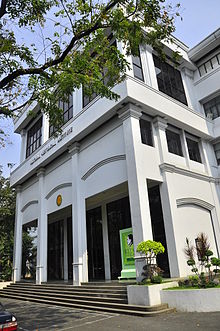- National Historical Commission of the Philippines
-
The National Historical Commission of the Philippines (Filipino: Pambansang Komisyong Pangkasaysayan ng Pilipinas, abbreviated NHCP) is part of the government of the Philippines. Its mission is "the promotion of Philippine history and cultural heritage through research, dissemination, conservation, sites management and heraldry works." As such, it "aims to inculcate awareness and appreciation of the noble deeds and ideals of our heroes and other illustrious Filipinos, to instill pride in the Filipino people and to rekindle the Filipino spirit through the lessons of history."[1]
Contents
Institutional History
The present day NHCP was established in 1972 as part of the reorganization of government after President Ferdinand Marcos' declaration of martial law, but the roots of the institute can be traced back to 1933, when the American colonizers first established the Philippine Historical Research and Markers Committee (PHRMC).[2]
The American colonial period
The PHRMC was created by U.S. Governor General Frank Murphy, byf Executive Order 451, to identify and mark "historic antiquities" in Manila as a first step towards their preservation. The commission's mandate was later expanded to cover the whole of the Philippines.
This first committee was composed of: American journalist Walter Robb who served as chair; American Anthropologist H. Otley Beyer who would later be known as the father of Philippine Anthropology; Spanish Jesuit Fr. Miguel Selga, SJ; dean Edward Hyde from the University of the Philippines College of Engineering; and Filipino statesmen Jaime C. de Veyra, Conrado Benitez, and Eulogio “Amang” Rodriguez.
The Philippine Commonwealth
With the establishment of the Philippine Commonwealth in 1935, the PHRMC was replaced by the Philippines Historical Committee (PHC), which took over the same functions as its predecessor, as well as the tasks of repairing government-owned antiquities and acquiring antiquities owned by private individuals.
There are no known records of the activities of the committee during the Japanese occupation of the Philippines during World War II, but the present administration of the NHI hopes that current research on the activities of the Laurel government during that period will fill in the gap.
The postwar reconstruction years was a busy era for the PHC as there was a government interest in "the reconstruction of the past as a means to form nationhood." Reconstituted six months after independence and the inauguration of the Third Philippine Republic, the committee was first placed under the Office of the President, and then transferred to the Department of Education. During this time, it installed over 400 historical markers all over the archipelago; named and renamed various streets, plazas, towns and other public places; and acquired places and relics of heroes.
Reorganization During Martial Law
As the nation rebuilt itself, a number of other historical commissions were also created by law to commemorate the birth centennials of various Philippine heroes of the late 19th century. All of these commissions were eventually merged into one National Heroes Commission. Further restructuring resulted in this becoming the National Historical Commission (NHC), which is a name still sometimes applied to the NHI today. In 1972, President Ferdinand Marcos' declaration of martial law resulted in a reorganization of government and the renaming of the NHC as the National Historical Institute.
The NHCP Today
Today, the NHCP still undertakes all the functions of the previous commissions, most notably those of preserving historical sites and structures and serving as lead agency for the commemorations of Independence Day, Rizal Day. Since 2002 the NHCP has been under the able leadership of the Hon. Ambeth R. Ocampo as Chairman assisted by Executive Director Ludovico D. Badoy. On May 12, 2010, President Gloria Macapagal-Arroyo signed the law reverting the National Historical Institute into its original form as the National Historical Commission of the Philippines (NHCP or PKP for Pambansang Komisyon Pangkasaysayan).
References
- ^ National Historical Institute Website: About Us, http://www.nhcp.gov.ph/index.php?option=com_content&task=section&id=5&Itemid=4
- ^ Ocampo, Ambeth (November 11, 2008), "Looking Back: A personal introduction", Philippine Daily Inquirer, http://opinion.inquirer.net/inquireropinion/columns/view/20081111-171631/A-personal-introduction
External links
Government
cultural
agenciesNational Commission for Culture and the Arts · National Historical Commission of the Philippines · National Museum · National Library · National Archives · Cultural Center of the Philippines · Komisyon sa Wikang Filipino · Sentro Rizal
Categories
of cultural
propertiesUNESCO World Heritage Sites · National Cultural Treasures · Important Cultural Properties · National Historical Landmarks · National Shrines · National Monuments · National Heritage Houses · Works of National Artists · Marked Structures · Other Cultural PropertiesCategories:- Government of the Philippines
Wikimedia Foundation. 2010.

